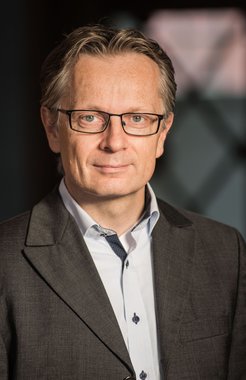Volker Springel appointed as new director at MPA

For several months, until August 2018, Volker Springel will still devote most of his working time to his current position as group leader at the Heidelberg Institute for Theoretical Studies (HITS) and his professorship in Theoretical Astrophysics at Heidelberg University before he will be based in full at the Max-Planck Institute for Astrophysics (MPA). He succeeds Simon White, his former PhD supervisor, and will focus mainly on cosmic structure formation, a research area which he significantly shaped with his program code GADGET and the Millennium Simulation. This simulation in 2005 was the first (and for a long time the only one) to track the development of more than 10 billion particles on a supercomputer over the age of the universe.
It is astonishing, how well the resulting "cosmic net" of galaxies and clusters of galaxies connected by filaments agrees with the actual observed distribution of the large-scale structures in the universe. By publishing the Millennium Data, which many other researchers have then been able to use for their studies, the Millennium Simulation achieved a major impact on cosmology, which has been further enhanced by the follow-up projects Millennium-II and Millennium-XXL.
At the same time, Springel developed an innovative method for the calculation of hydrodynamics on a moving dynamic lattice and implemented it in the cosmological code AREPO. This enabled him to perform the groundbreaking Illustris simulation (and most recently IllustrisTNG), the first major cosmological hydrodynamic simulation of galaxy formation that can actually reproduce the observed mixture of spiral, barred and elliptical galaxies. He also focused on galaxies similar to our Milky Way, which he investigated with the Aquarius project and the Auriga simulations. These simulations have become more and more sophisticated; they now include magnetic fields and can provide an explanation of their origin. Other physical processes, such as the interaction between star formation and the interstellar medium or the growth of black holes are now also included in the simulations.

After completing his doctoral thesis at MPA, Springel initially worked as postdoc at the Harvard-Smithonian Center for Astrophysics in Cambridge, USA, returned to MPA for several years before he became a professor at the University of Heidelberg in 2010 and at the same time accepted a position as head of the research group "Theoretical Astrophysics" at the newly founded Heidelberg Institute for Theoretical Studies (HITS). He has won many awards for his groundbreaking work. He has received the Otto Hahn Medal of the Max Planck Society, the Heinz Maier-Leibnitz Prize of the German Research Foundation, the Klung Wilhelmy Weberbank Prize for Physics, was a member of the Young Academy of the Berlin-Brandenburg Academy of Sciences and the Leopoldina, of which he was elected a regular member in 2016, and has been an external scientific member of the MPI for Astronomy in Heidelberg since 2012.
At the MPA, Volker Springel will continue to refine his computer simulations and will focus in particular on taking into account small-scale and previously poorly understood physical processes in large-scale simulations. What regulates star formation in galaxies? How do different theoretical assumptions for Dark Matter and Dark Energy affect the cosmic structures? How do you manage to reach huge masses beyond one billion solar masses shortly after the Big Bang? These are just a few of the questions Volker Springel wants to answer with new calculations on supercomputers.

